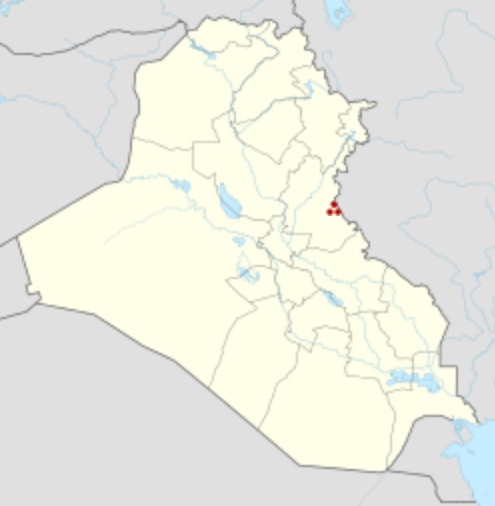CHOGA
MAMI

Choga
Mami shown within Iraq
Location
:
Diyala Province, Iraq
Region
:
Mandali region
Coordinates
:
33.883330° N 45.449990° E
Type
:
Settlement
History
:
Material
:
Mud Brick
Founded
:
5600 BC
Abandoned
:
4800 BC
Site
notes :
Excavation
dates :
1967-1968
Archaeologists
:
Joan and David Oates
Condition
:
In ruins
Choga
Mami is a Samarran settlement site in Diyala province in Eastern
Iraq in the Mandali region. It shows the first canal irrigation
in operation at about 6000 BCE. It is no longer clear which way
cultural developments were flowing in the 6500 to 4500 BCE period.
The
site, about 70 miles northeast of Baghdad, has been dated to the
late 6th millennium BCE. It was occupied in several phases from
the Samarran culture through the Ubaid. Buildings were rectangular
and built of mud brick, including a guard tower at the settlement's
entrance. Irrigation supported livestock (cattle, sheep and goats)
and arable (wheat, barley and flax) agriculture.
One
important aspect of the site therefore is the evidence that it yields
for chronological relationships between North and South Mesopotamian
cultures, at least in the area of Mandali, and for connections with
Iran. The introduction of irrigation, new types of grain, foreign
ceramic styles and domestic cattle are all located in the Choga
Mami phase, a late manifestation of the Samarran Period in lowland
Mesopotamia. This chronological identification thus also suggests
the source of these innovations: migration from the lowlands.
Artifacts
found at Choga Mami include Samarran painted pottery and elaborate
clay female figurines.
History
:
Choga Mami is the largest Tell in the Mandali region. Excavators
David and Joan Oates describe the site as a "low mound some
200 meters long and 2-5 meters high," and "heavily eroded,
the latest preserved levels dating to 4800 B.C." Based on excavation
findings, it appears that Choga Mami had a few small village clusters
with small irrigated areas where people grew wheat and barley; herded
sheep, goats and some cows; and hunted gazelles and other wild fauna.
Lentils and "large-seeded peas" were also grown, while
pistachios were gathered from the nearby landscape. The domestication
of plants and animals at Choga Mami was possible because of man-made
irrigation channels which "ran along the northern side of the
mound," which date from the "6th millennium B.C.,"
and a large canal dating to the end of the Samarran period which
was located at the "southwestern side of the mound." Some
channels reached more than five kilometers in length, which would
require the cooperative labor of larger groups. The latest of these
canals can be dated to around 1,500 years ago.
Archaeology
:
Choga Mami was originally excavated by a team of archaeologists,
led by Joan and David Oates. The first season of this excavation
project began on December 2, 1967 and would extend until February
26, 1968. The archaeological site of Choga Mami was chosen for excavation
in part due to its location in Iraq, along an area which would have
ostensibly seen heavy foot traffic during the time, in which it
would have been considered part of the Mesopotamian region. During
the excavation the team of archaeologists found mud brick rooms
all similar in size and thoughtfully aligned, pottery, tools, and
many small clay figures. David Oates also found a jar containing
the fragmented remains of what is presumably an infant burial, which
led them to believe that this location would have been the site
of a small town.
Architecture
:
Excavations at Choga Mami have revealed many levels of occupation
on the tell, dating from the start of the 6th millennium B.C. A
mud-brick tower guarded the entrance to the settlement. There is
no clear evidence that it formed part of a town wall, and encouraged
by a part of an ascending ramp found beside it, archaeologists identify
the structure as a watch tower. Built out of locally sourced mud
brick, the settlement had Samarran-style, rectangular shaped homes.
The homes found at Choga Mami were built directly on top of, or
occasionally within, the walls of earlier levels. The majority of
houses "contained either two or three rows of small rooms,"
on either side of a central hall, referred to as a tripartite plan.
This plan is common throughout Mesopotamia in both public and domestic
architecture. Many of the houses found at Choga Mami were strengthened
by external buttresses, corresponding with "the corners and
junctions of walls." The largest house found by excavators
measured 10 x 7 meters and contained twelve rooms in three rows.
Despite being rendered obsolete by architectural innovations later
in the period, these buttresses are found at all levels of occupation,
resulting in purely decorative use of the buttress by the end of
the Samarran period.
Ceramics
/ Pottery :
The surviving pieces of pottery found at Choga Mami were regularly
constructed with the same materials and the same overall look as
those of the wider Samarran Culture. Many remaining examples display
an extensive use of animal imagery, a defining characteristic of
the period. Among the clay artifacts that have been excavated at
Choga Mami, both painted and unpainted pots, clay beads, and small
figurines have been recovered. While standing male and female Terracotta
figurines are the most common, other figurines largely resemble
the figures of the later Ubaid period, found in southern Iraq. These
small baked terracotta figurines are often depicted as standing
male or female statutes with their hands at their waist and intricately
decorated, yet depicted with exaggerated body proportions. Many
have the appliqué eyes, scalloped hairstyles and beauty marks,
typical of the pottery of the larger Mandali region. Few Terracotta
figurines have been found fully intact due to their composition.
Most remain fragmentary, as these figurines were often assembled
with added on smaller pieces, which have broken off over time at
the joining point.
Source
:
https://en.wikipedia.org/
wiki/Choga_Mami

